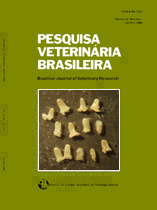 |
|
|
|
Year 2014 - Volume 34, Number 4
|

|
Antimicrobial susceptibility of Staphylococcus spp. isolated from canine superficial pyoderma, 34(4):355-361
|
ABSTRACT.- Silva A.P., Schmidt C., Vargas A.C., Maboni G., Rampelotto C., Schwab M.L., Escobar T.P. & Amaral A.S. 2014. [Antimicrobial susceptibility of Staphylococcus spp. isolated from canine superficial pyoderma.] Suscetibilidade antimicrobiana de Staphylococcus spp. isolados de cães com pioderma superficial. Pesquisa Veterinária Brasileira 34(4):355-361. Hospital Veterinário, Departamento de Clínica de Pequenos Animais, Centro de Ciências Rurais, Universidade Federal de Santa Maria, Av. Roraima 1000, Prédio 97, Camobi, Santa Maria, RS 97105-100, Brazil. E-mail: apsvet@hotmail.com
A total of 154 samples of skin lesions were obtained from dogs with superficial pyoderma that were assisted by the Veterinary Dermatology Service at the University Veterinary Hospital (HVU), Universidade Federal de Santa Maria (UFSM), aiming to determine the antimicrobial susceptibility of Staphylococcus spp. isolates and evaluate the presence of multidrug resistance profile. After bacterial isolation and identification, the strains were tested for antimicrobial susceptibility, and the results showed lower percentages of resistance to the amoxicillin and clavulanic acid association (1.9%), cefadroxil (1.9%), cephalexin (1.9%) and vancomycin (0.6%). The highest percentages were towards amoxicillin (60.4%) and penicillin G (60.4%). The multidrug resistance was detected in 23.4% and the methicillin resistance in 5.8% of the samples. It may be concluded that the Staphylococcus spp. isolates present high susceptibility to key antimicrobials used in the treatment of superficial pyodermas in dogs at the HVU-UFSM, such as cephalexin and the amoxicillin and clavulanic acid association, confirming the preference for these drugs when treating dogs with this disorder. The susceptibility of the strains to fluoroquinolones, also recommended in the literature for the treatment of pyodermas, allows suggesting that such drugs should not be considered in the empirical selection. The identification of multidrug-resistant Staphylococcus spp. in the studied canine population justifies periodic and regional bacteriological tests of skin lesions in dogs with superficial pyoderma, possible therapeutic failures and also motivates wise use of antimicrobial therapy. |
| |
|
|
| |
|
 |